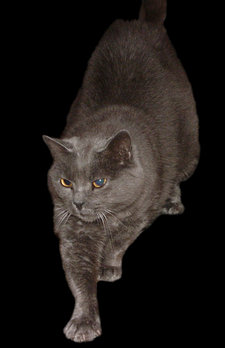 |
 |

CAT BREEDS A-Z Chartreux Physically, the Chartreux is large and muscular with short but powerful limbs, big paws and very fast reflexes. They are known for their blue (grey) double-thickness fur coats and gold- or copper-colored eyes. Chartreux cats are known for their "smile"; due to the structure of their heads and long, tapered muzzle, they often appear to be smiling. Chartreux cats tend to be quiet, rarely making noises such as mewing or crying. Some are mute. They are quite observant and intelligent, with some Chartreux learning to operate radio on/off buttons and to open screen door latches. Chartreux cats are also fond of chasing and playing well into their adult years; some can be taught to fetch small objects in the same manner as a dog. Chartreux are good with children and other animals, are nonaggressive and affectionate, good travelers and are generally very healthy. Historically famous Chartreux owners include the French novelist Colette and French general/president Charles de Gaulle. The Chartreux breed was advanced to championship status in 1987 by the Cat Fancier's Association (CFA.) |
Please don't forget to leave your paws in the Purrfect guestbook!!!
Top Of Page | Back | About Us | Home | Choosing A Cat | Behaviour | Care | Health | Breeds | Facts | Humour | Poems Glossary | My Cat Pictures | Books | Links | Bookmark | Contact Us | Terms Of Use | Disclaimer | Privacy Policy
Copyright © 2006 ThePurrfectPaws
All Rights Reserved.
Feline Illustrations by Abida
Fahim
 damage. Legend has it the Chartreux's ancestors were feral
mountain cats from what is now Syria, brought back to France
by returning Crusaders in the 13th century, many of whom entered
the Carthusian monastic order. The first documented mention
of the breed was by the French naturalist Buffon in the 17th
century. The first Chartreux were brought to the USA in 1971.
damage. Legend has it the Chartreux's ancestors were feral
mountain cats from what is now Syria, brought back to France
by returning Crusaders in the 13th century, many of whom entered
the Carthusian monastic order. The first documented mention
of the breed was by the French naturalist Buffon in the 17th
century. The first Chartreux were brought to the USA in 1971.
